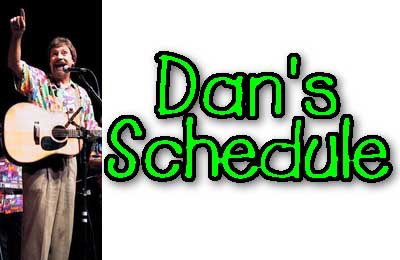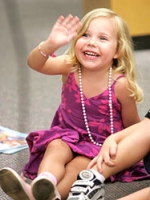

The Program
Dan Crow’s program consists of delightful participatory songs and stories, each concentrating on a skill in phonics or grammar. Based on audience participation, the performance offers a high interest phonic/phonetic approach to reading. It develops positive feelings of self-expression, while creating and improving basic speech and language skills.
Instructional Objectives
-
To improve vocabulary skills
-
To improve communication/listening skills
-
To learn to appreciate the humor and the art of language
-
To increase phonemic awareness
-
Explore the joy of imagination
Suggestions for Preparation
Questions (to encourage attention):
-
What are the differences between vowels and consonants?
-
What are the differences between nouns and pronouns
-
What does “phonetic” mean?
Activities (prior to the performance):
-
Listen to the sounds of the alphabet and then discuss how the sounds are produced (voiced “b” vs. unvoiced “p”).
-
Recite some tongue-twisters and discuss why such phrases are so difficult.
Vocabulary
Noun: a word that is the name of something (person, place or thing) that can be talked about
Palindrome: a word, phrase, verse or sentence which reads the same backwards as forwards
Homophone: One of two or more words pronounced alike but with different meanings (red, read; pare, pear, pair)
Etymology: The history of a word shown by tracing it or its parts back to the earliest known forms and meanings both in its own language and any other language from which it may have been taken.
Alliteration: The repitition of a sound at the beginning of two or more neighboring words (as in “wild and woolly” or “babbling brook”)
Metaphor: A figure of speech in which a word denoting one object is used in place of another to suggest a likeness between them
Mythology: A collection of legendary stories that describe a supernatural being or event or explains a religious belief or practice
Suggestions For Follow-up
-
Make a worksheet of the song lyrics and have the students locate and circle the sound for which the song was written.
-
Students can write or offer OTHER WORDS that contain each particular sound.Examples: Things found in the classroom, on the school grounds. at home in the ocean, at the circus, etc.
-
Students can write their own ditties, “silly sound songs” or poems.
-
Art activities can be used in conjunction with the story songs. This can help develop listening skills.
-
Sing, learn and have fun with the songs. Auditory stimulation becomes an important by-product.
-
Go to the garden, playground, circus, zoo etc. and list or discuss the different things you see, hear or smell.
-
Learn some fun words in other languages (i.e. how to say hello, good-bye or thank you)
Bibliography & Resources
Oops, by Dan Crow. cassette/CD. Rounder Records 8007.
The Word Factory, by Dan Crow. cassette/CD. Vocabulary, Parts of Speech, Palindromes and Word Play. ALLS HOUSE Family Entertainment 1949.
A Friend, A Laugh and A Walk In The Woods, by Dan Crow. cassette/CD. Songs about nature, friendship, and humor. ALLS HOUSE Family Entertainment 1950.
Dan Crow Live, by Dan Crow. CD. A double CD of nearly 90 minutes of stories and songs performed before an audience. ALLS HOUSE Family Entertainment 1951.
Chanukah At Home, cassette/CD. Original and traditional songs on this Chanukah anthology album. Rounder Records 8017.
Santa Songs, by Dan Crow. CD. Delighful songs of the season. ALLS HOUSE Family Entertainment 1952.
Just For Fun, by Dan Crow. A 12 minute Emmy Award Winning video
The Giggling Dragon, by Dan Crow. CD. Designed to encourage reading and writing skills and develop the imagination, ALLS HOUSE Family Entertainment 1955
Meet the Artist
Specific Educational Standards met with The Reading, Writing and Rhythm Assembly Program
Visual and Performing Arts: Music Content Standard
Kindergarten:Artistic Perception 1 .O; Creative Expression 2.1, 2.2; Historical and Cultural Content 3.1, 3.4; Aesthetic Valuing 4.1, 4.2; Connections Relationships Applications 5.1
Grade One: Artistic Perception 1.2; Creative Expression 2.1, 2.2; Historical and Cultural Content 3.1, 3.2; Aesthetic Valuing 4.2; Connections Relationships Applications 5.1, 5.2
Grade Two: Artistic Perception 1.4; Creative Expression 2.2; Historical and Cultural Content 3.1, 3.2;Aesthetic Valuing 4.1, 4.4; Cornnections Relationships Applications 5.1, 5.2
Grade Three: Artistic Perception 1.3, 1.6; Creative Expression 2.1 ; Historical and Cultural
Content 3.1, 3.2, 3.4; Aesthetic Valuing 4.1, 4.3; Connections Relationships Applications 5.2
Grade Four: Creative Expression 2.1 ; Historical and Cultural Content 3.1, 3.2, 3.5; Aesthetic Valuing 4.1, 4.2
Grade Five: Artistic Perception 1.6; Creative Expression 2.1 ; Historical and Cultural Content 3.1, 3.2, 3.3; Aesthetic Valuing 4.2; Connections Relationships Applications 5.2
English Language Arts Content Standard
Kindergarten: Reading 1.7, 1.8, 1.9, 1.10, 1.12, 1.13, 1.16, 1.17, 3.1, 3.2; Listening and Speaking 1 . l , 2.3
Grade One: Reading 1.3, 1.1 0, 1.12, 1.1 7; Listening and Speaking 1.1, 1.3, 2.1, 2.2
Grade Two: Reading 1.2, 1.1 0, 3.4; Written and Oral Language Connections 1.3; Listening and speaking 1.1, 1.4, 1.7,2.1
Grade Three: Reading 1.4, 1.7, 2.4, 2.7, 3.2, 3.5; Writing 1.3, 2.3; Written and Oral Language Connections 1.2; Listening and Speaking 1.4, 1.7, 1 .1 1
Grade Four: Reading 3.1, 3.5; Written and Oral Language Connections 1.2; Listening and Speaking 1.3, 1.8, 1.9, 2.1, 2.4
Grade Five: Reading 1.3, 1.5, 3.1 ; Written and Oral Language 1.2; Listening and Speaking 1.2, 1.6, 2.1





 Click here to find out where to see Dan Crow Live!
Click here to find out where to see Dan Crow Live!





